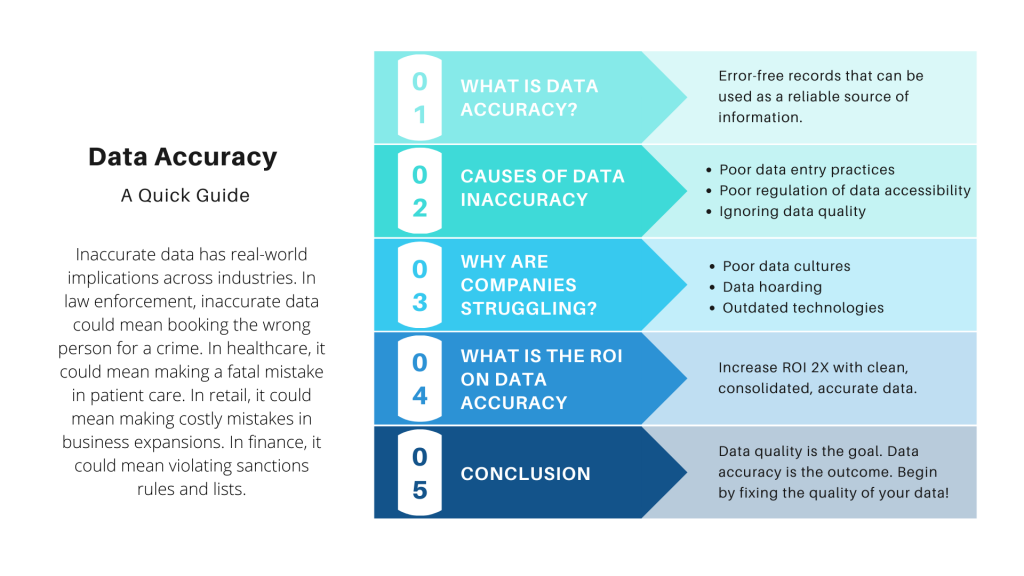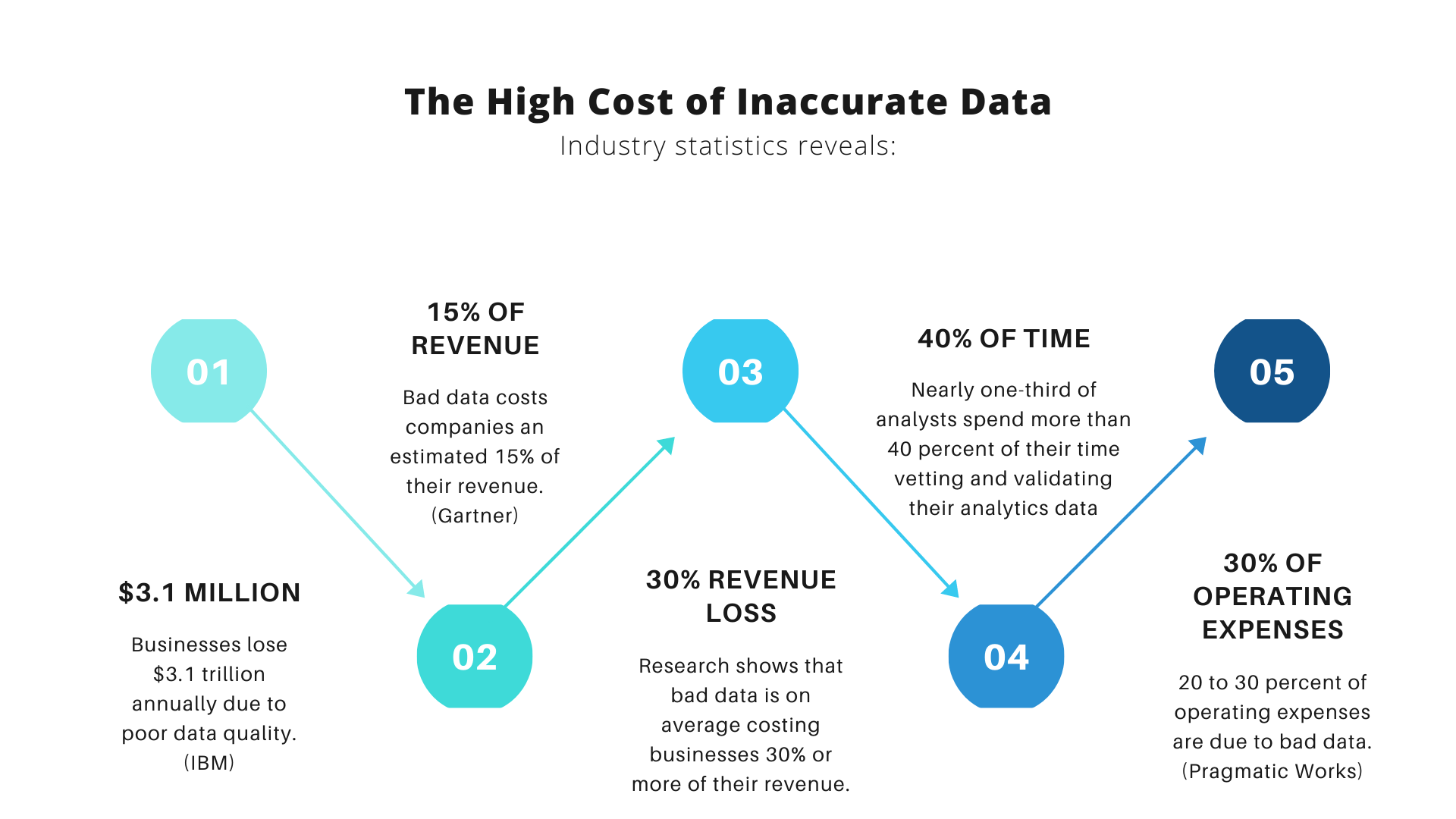How To Find The Accuracy Of A Data Set
Inaccurate data has real-world implications across industries. In police force enforcement, inaccurate data could mean booking the incorrect person for a law-breaking. In healthcare, it could mean making a fatal mistake in patient care. In retail, it could mean making plush mistakes in business expansions. In finance, it could mean violating sanctions rules and lists.
Data accuracy is no longer "just" a component of data quality. It is quite literally the most important characteristic that makes data usable and purposeful.
In this detailed guide, I'll exist covering everything you need to know about:
- What is data accuracy?
- What the causes of information inaccuracy
- The high toll of data inaccuracy
- Why it'southward essential to maintain data accuracy
- Why are companies struggling with data quality and data accuracy?
- What steps you can take to improve data accuracy
- Some examples and of import case studies
Allow's dig in.
What is Data Accuracy?
Information accuracy refers to error-gratis records that can be used as a reliable source of information.
In data management, information accuracy is the first and critical component/standard of the data quality framework. A popularly cited work, Data Quality: The Accurateness Dimension by Jack Olson explains form and content as two of the near important characteristics of information accuracy.
Here's an example:
In the United states of america database, dates follow the MM/DD/YYYY format, whereas, in the EU database and other countries of the world, it's DD/MM/YYYY. If 09/x/2020 was converted to content, which of the two do you lot think would be authentic?
Is it September 10thursday or is information technology 9th October? This is the classic pregnant vs class problem that threatens information accuracy. And this more often than not happens due to the lack of data standardization and rules.
It's imperative that any information stored in a information warehouse is accurate and appropriate for use. It impacts an organization'southward concern intelligence, forecasting, budgeting, and other critical activities. If the information is irrelevant, incorrect, incomplete, and inaccurate it can disrupt processes & hamper operational efficiency.

What are the Causes of Data Inaccuracy?
The causes of data inaccuracy are many. Some of the about common causes are:
Poor Information Entry Practices:Data inaccuracy is the result of poor information entry practices. An arrangement that does not have information governance in place will see data entered in multiple formats, styles and varieties. For case, one client's proper name may be written in 3 dissimilar means by three different reps. Worse, information acquired from social media is highly decumbent to mistakes, typos and copy/paste errors.
Not Regulating Information Accessibility: The CRM is a practiced instance of this point. Accessed simultaneously by sales, marketing, customer service, and account managers, CRMs tin become a hotbed of duplicated, inconsistent, inaccurate information. For instance, a marketing rep may want to verify the client's company name earlier publishing a example report, simply to see an incorrect spelling or a short course of the name in the Company Name field, that was possibly typed or modified by a sales rep. The marketing rep will have to become through multiple verification rounds to fix this error. Worse, the customer may cease upward pointing the error if the case study was published without verification.
Information Quality is Non Commonly Addressed:Teams are besides decorated with selling, marketing and promotion to think about incorrect data in the data set. Leadership is too decorated thinking of investments in cloud, large data systems, fancy software and technologies to worry about data. It teams are too busy helping leadership in 'transforming' to fret about disparate, duplicate, inaccurate data. Data quality or accuracy is not a boardroom discussion matter. It only comes into the spotlight when something goes drastically wrong similar a flawed report or an ineffective marketing entrada.
All these causes lead to losses in millions.
The High Toll of Inaccurate Information
Some statistics to bulldoze home the point.

- Bad data costs companies an estimated fifteen% of their revenue. (Gartner)
- The average financial impact of poor data quality on organizations is $9.7 million per year. (Gartner)
- In the US lone, businesses lose $3.1 trillion annually due to poor data quality. (IBM)
- Multiple research reports have shown that bad data is on average costing businesses 30% or more than of their revenue.
- Nearly 1-third of analysts spend more than 40 percentage of their time vetting and validating their analytics data. (Forrester)
- Knowledge workers waste material 50% of their time in subconscious data factories, hunting for data, finding and correcting errors, and searching for confirmatory sources for data they don't trust. (HBR)
-
- 28% of those who have had problems delivering email say that client service has suffered as a result of bad data. (E-Consultancy)
- 20 to thirty per centum of operating expenses are due to bad information. (Pragmatic Works)
These statistics prove that inaccurate, poor data is a persistent problem in most organizations and one that has a tremendous bear on on ROI, company reputation, and client confidence.
Why It's Essential to Maintain Data Accuracy
Insights. Analytics. Intelligence.
The three primary goals companies want to accomplish with data. This is non accomplished by more than data. It's accomplished by accurate, complete, timely, reliable data.
It is through these goals that a business makes key decisions such as:
- Expansion to a new market
- Launching a new service
- Understanding market position
- Understanding competitors
- Agreement customers & personalizing client services
- Enabling efficient company processes
… and so much more than. Depending on the manufacture, data accuracy tin brand or break businesses. The real-world implications of inaccurate data cannot be ignored.
Why are companies struggling with data quality and data accuracy?
Millions are being invested in data direction solutions. Yet, an HBR written report involving 75 executives reveals only 3% found that they had accurate data within the acceptable range of 97 or more than correct records out of 100.
Companies are struggling with maintaining data accurateness because their focus is only on gathering more data, instead of making current data usable.
In our feel with 4,500+ clients, there are three essential roadblocks preventing companies from maintaining accurate records.
Poor Data Culture: Companies have not yet truly embraced a data-driven culture. At that place is meaning investment in technologies merely lilliputian to no investment in data awareness training. Employees are more often than not oblivious to concepts like data quality or information accuracy. For a long at present, these practices have been restricted to the IT department. When information technology comes to customer data, business employees make changes at will with no adherence to any divers standards or data quality protocols. These gaps make it incommunicable for companies to attain data accurateness, therefore compromising on data integrity.
Data Hoarding Instead of Being Data-Driven: At that place'due south really no end to data hoarding. Companies are spending millions in big data technologies gathering more information every passing day. But there is no organization in place to make sense of that data. There are no resource available to clean, sort, manage the data in time. There is no automation and definitely no processes put in place to resolve information quality issues which leads to the third obstacle.
A Stubborn Reliance on Outdated Methods and Technologies: In most organizations today, information is however manually prepared using Excel, SQL or ETL tools. All of which are incapable of handling the complexities of modern data – especially customer data obtained via social media, third-party vendors or web forms, or chatbots. Rife with errors, inaccuracies, and oddities, this information cannot be manually treated or prepared as it would take months for a company to clean and match thousands of rows of data.
Not acknowledging the urgent demand to ensure data quality hampers your progress and affects your ROI – which leads to our adjacent of import point below.
How to Calculate the ROI on Information Accuracy
ROI determines all if non almost corporate decisions. Like every other process, we volition tie our best to justify spending on data quality by measuring its ROI and about executives will employ a traditional approach to this:
How much volition we make in $ if we spend $ in fixing our data?
Well, hither's a non-traditional answer.
You increase your ROI when:
- Your company *DOES NOT* make mistakes because of bad information.
- You don't spend every dollar fixing every tape.
- Your teams take access to a clean, centralized information source to piece of work with.
- The benefit of fixing information outweighs the cost of covering up mistakes and inefficiencies caused by bad data.
- You lot make confident decisions based on insights and intelligence reports derived from accurate data.
Fact is, the ROI of any data quality initiative is elusive. Just the cost of poor information is pretty much evident. Businesses lose millions of dollars annually because of duplicates, outdated data, incomplete data, mismatched data, inaccessible and disparate data.
Here's an case:
A subscription-based online learning visitor needs to match a 1000000 records obtained from three sources: atomic number 82 forms, CRM, client service.
Using traditional ETL tools, the company performs the lucifer only ends up with three.5% of false negatives and vi.8% of false positives. This figure alone has costed the company hundreds of dollars in sales, manpower hours (in manually reviewing each false negative and positive). If the company had undertaken a information quality initiative serious, they would take prevented 11% of their total records from existence wasted.
11% of a meg = 11,0000
Assuming each client pays $100
That'southward 11,0000 10 100 = 11000000
Eleven million in wasted revenue. That's a huge blow to any company's profitability.
Ready to do what'south necessary to ameliorate information accurateness?
Here'south what you lot can offset with.
What Immediate Steps Can Yous Take to Improve Data Accuracy?
Y'all may exist tempted to hire a data analyst. Or perhaps change your CRM. Or maybe task your IT teams (again) to come upwardly with a solution.
Stop.
None of this is going to work.
So, what will?
Some immediate steps I recommend would exist:
- Conduct a data quality audit. Find out the top five bug affecting your data quality. Some of the most common issues yous'll find would be duplicates, incomplete information and data stored in multiple silos with more than half of them either obsolete or long lost forgotten.
- Measure out the estimated bear on. Say you have a thousand new leads this month. How many of those leads are actually usable? If information technology'south just a two, or three hundred, you're losing revenue.
- Measure the manpower needed to ready this data. How much fourth dimension are your reps spending in verifying and fixing information? Are they doing it manually? How many phone calls are existence fabricated and what is the average elapsing of each call? Assess the cost of manually fixing this data. If information technology's taking your team a calendar month to verify, clean, dedupe and fix a 1,000-row data ready, you need to look for a faster, more automated solution.
- Opt for an automated solution: While auditing your information, yous might realize yous need a information lucifer solution that tin can assist you remove duplicates and mayhap consolidate multiple data sets from multiple sources into a consolidate, aureate tape. Most organizations utilize Data Ladder'southward DataMatch Enterprise solution for data matching and to dedupe information. Forth with that, they besides get to contour, clean, standardize and set up their data.
- Hire a information analyst to manage information preparation: Y'all may remember of hiring a data analyst and allow them exercise the cleaning, just that's hardly the right use of their skills. Your data analyst must be empowered with the right tools and resources to help them help y'all get accurate information. They must exist the thinkers and the strategist while the solution yous equip them with is the doer. Your annotator must non spend 80% of their time doing janitorial work (experts claim data cleansing equally data janitorial work and that's not fun!). Let the solutions exercise the cleaning and let your analysts practise the thinking!
- Focus only on specific information sets to fix as opposed to a whole data source: It's impossible to perform a blanket operation on your entire data source or database. Not only volition that be useless, but it volition also exist a waste matter of effort. Instead, focus on optimizing data you demand for immediate tasks – such as cleaning data of the final six months to ready for a bi-annual report, or information of the concluding quarter to gear up a promotional entrada. Every bit you focus on fixing the important data get-go, you'll gradually go around to sorting other data and get to make up one's mind what y'all want to go along and what you desire to discard.
With these immediate steps, you can prepare your teams to handle essential business operations such as an upcoming migration initiative, a major promotional campaign or a business intelligence report. The fundamental goal to possessing authentic data is to ensure data integrity. Your data can make or break your business. Exercise you intendance enough to gear up it?
Cleveland Brothers Case Study
Cleveland Brothers Equipment Company Inc. operates as an equipment dealer and supports a number of industries that include construction, agriculture, power generation, landscaping and more. This ways the visitor deals with multiple customer data sets coming from multiple sources, with multiple interests and needs.
The company needed a data quality management solution that could allow them to dedupe information, cross-reference contact information such as names, phone numbers, billing addresses, and company names. They also needed the solution to help them with data cleansing and data standardization.
DataMatch Enterprise was the company's tool of option that helped them perform several key operations at once and because the tool is piece of cake to employ and requires no additional programming expertise, even the company's business resources were able to prepare data easily.
Cleveland Brothers Case Study
Download case study and run into how the leading equipment reseller saves fourth dimension managing multiple customer lists.
Download
To Conclude: Don't Compromise on Data Accuracy. Your Company Needs Information It Tin Trust
Data quality is the goal. Data accuracy is the consequence. With the right human and technological resource, your company will be in a better position to footstep into the future confidently.

How best in class fuzzy matching solutions piece of work: Combining established and proprietary algorithms
Download
Start your free trial today
Oops! We could not locate your class.
Source: https://dataladder.com/what-is-data-accuracy/

0 Response to "How To Find The Accuracy Of A Data Set"
Post a Comment